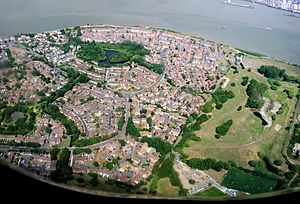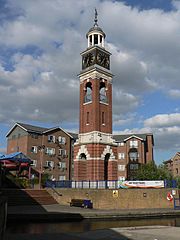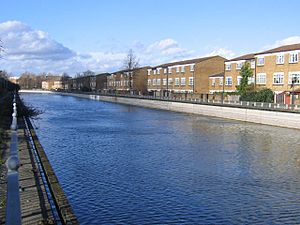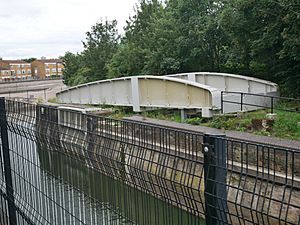Thamesmead facts for kids
Quick facts for kids Thamesmead |
|
|---|---|
 Aerial view of Thamesmead in July 2015 |
|
| Population | 31,824 (Thamesmead Moorings and Thamesmead East wards 2011) |
| OS grid reference | TQ475805 |
| • Charing Cross | 10.6 mi (17.1 km) W |
| London borough | |
| Ceremonial county | Greater London |
| Region | |
| Country | England |
| Sovereign state | United Kingdom |
| Post town | LONDON |
| Postcode district | SE2, SE28 |
| Postcode district | DA18 |
| Dialling code | 020 |
| Police | Metropolitan |
| Fire | London |
| Ambulance | London |
| EU Parliament | London |
| UK Parliament |
|
| London Assembly |
|
Thamesmead is an area in south-east London, England. It sits on the border between the Royal Borough of Greenwich and the London Borough of Bexley. This area is about 11 miles (18 km) east of Charing Cross. It is also north-east of Woolwich and west of Erith. Thamesmead is mostly made up of homes built from the mid-1960s onwards. These homes were constructed on former marshland next to the River Thames.
Contents
Thamesmead's Past
Military History
Much of Thamesmead was once part of the old Royal Arsenal site. This large area covered about 1,000 acres (4 km²) of marshland. Evidence shows people lived here long ago. Flint tools and animal bones were found in 1997.
During Roman times, the river level was much lower. Digs in 1997 found signs of ancient fields and pottery. These items date back to the 3rd or 4th century. After the Romans, the river rose again, turning the area back into marshland. Monks from Lesnes Abbey helped drain some of this land by 1279.
Between 1812 and 1816, a canal was built by convicts. It moved materials like wood from the River Thames to Woolwich Royal Arsenal. Most of this canal has been filled in. However, a part of it remains in Thamesmead West. It is now called the Broadwater. An old lock gate and swing bridge still stand by the River Thames.
How Thamesmead Began
Thamesmead was built starting in the late 1960s. Builders wanted to avoid problems seen in older housing areas. These problems included people feeling lonely after moving from close-knit communities. The new design aimed to make people feel more connected.
One new idea came from Sweden. Architect Robert Rigg believed that lakes and canals could reduce crime. He thought water would have a calming effect on residents.
Thamesmead was designed with a modern, futuristic look. It had raised walkways between buildings. But these walkways soon became dirty and unsafe. Many paths were not used because people found quicker ways to get around.
The Greater London Council (GLC) built most of Thamesmead. They rented homes to families from crowded old houses in Inner London. The area had flooded badly in 1953. So, homes were designed with living areas on the first floor or higher. Ground floors were often used for garages. There is also a raised "escape route" for floods. It runs along a grassy mound north of the Lesnes area.
The first homes were ready in 1968. But problems with rain getting in started early. The older parts of Thamesmead have concrete buildings. These have appeared in films because of their "rough urban look." Newer buildings are made of brick and look more traditional.
Design Challenges
Thamesmead faced challenges with its design. It was hoped the Jubilee Line Extension would reach Thamesmead. But the train line went to Stratford instead. This left Thamesmead without a direct underground train link.
Thamesmead is also cut off from north London by the River Thames. It is located between the Blackwall Tunnel and the Dartford Tunnel. There have been ideas for a new river crossing. But none have been built yet.
A big problem was the lack of shops and banks. Only a few small shops were built at first. Thamesmead was also separated from Abbey Wood, the nearest town with shops, by a railway line. A road bridge was built over the railway in the 1970s.
Over time, more shops opened. A Morrisons supermarket and retail park were built. Bus services also got better. Now, residents can easily reach Abbey Wood railway station.
Thamesmead Today

Thamesmead now has a retail park with a Morrisons Supermarket. There is also a shopping area with hairdressers and estate agents. This area features a clock tower and a lake. Some of the old raised walkways have been taken down for safety. Some ground-floor garages are no longer used for parking due to safety concerns.
Thamesmead West has Gallions Ecopark. This is a new housing area with energy-efficient homes. It also has a small lake and man-made hills for views. The biggest is Gallions Hill, which is 20 meters (66 ft) high. It has a spiral path to the top.
Part of Thamesmead West is sometimes called Gallions Reach Urban Village. This can be confusing because it is across the river from Gallions Reach DLR station. Thamesmead West does not have a train station.
New homes are still being built in Thamesmead. The final part of the Gallions Reach Urban Village is Gallions Reach Park. This is a 14.3-acre (5.8 ha) public park. Water features are still important in the parks and open spaces.
In 2014, several housing groups in Thamesmead joined Peabody Trust. Peabody plans to build 20,000 new homes. This would increase the number of residents to about 80,000.
There are plans for a Docklands Light Railway extension to Thamesmead. This train line would connect Thamesmead to the DLR network. A public survey about this plan started in February 2024.
Thamesmead's Location
Thamesmead is 11 miles (18 km) east of central London. It is on the same line of latitude as Westminster. In Thamesmead East, the River Thames curves furthest north in Greater London. This is near the Crossness Sewage Treatment Works.
Main Areas
Thamesmead has four main areas:
- Thamesmead South is in Bexley. It has the original buildings from the late 1960s and early 1970s. These buildings are mostly concrete and have a modern style. Some are tall high-rise blocks.
- Thamesmead North is in Greenwich and Bexley. It was built from the 1970s onwards. It first had grey brick townhouses. Newer buildings use red and yellow brick.
- Thamesmead Central is in Greenwich. It started in the early 1980s. It had large concrete and red brick buildings. Now it also has red and yellow brick homes built from the 1990s.
- Thamesmead West (also called Broadwater Green) is in Greenwich. It is near Woolwich and Plumstead. It was built from the 1990s. It has many homes with yellow brick. There are also tall buildings along the river.
Belmarsh Prison, Isis Prison and Thameside Prison are on the west side of Thamesmead. The Crossness sewage works, built in the Victorian era, are on the east side. The southern border is the Southern Outfall Sewer. This has been turned into a raised walking path called the Ridgeway.
Nearby Places
Nearby areas include: Barking & Dagenham (across the Thames), Belvedere, Abbey Wood, Plumstead, Welling, Woolwich, Bexleyheath, Erith and Greenwich.
People of Thamesmead
Thamesmead's population is growing fast. In mid-2018, about 41,121 people lived there. This is a nearly 30% increase since 2011. Because of this growth, there is more demand for the planned DLR extension.
Like the rest of London, the people living in Thamesmead have become more diverse. When it was first built, most residents were white and working class. The area's location and lack of train links meant fewer immigrants moved there at first.
However, after the Fall of Saigon in the late 1970s, a small group of Vietnamese refugees settled here. In the 1990s, more people moved from West Africa, especially Nigeria and Ghana. The 2011 census showed that a large percentage of residents in some Thamesmead areas identified as Black African.
Thamesmead also borders the Thistlebrook travellers site near Abbey Wood.
Getting Around Thamesmead
Thamesmead's location makes it hard to build new roads and railways. It is between the River Thames and the South London hills. Because of this, Thamesmead does not have its own underground or above-ground train lines. It is one of the largest areas in London without a railway station. Most residents use buses to reach nearby train stations. There is an old railway track from Plumstead that once served the Royal Arsenal.
The London Assembly suggested extending the DLR from Gallions Reach to Thamesmead in 2016. A public survey about this idea started in February 2024.
Buses
Many bus routes serve Thamesmead. All are run by Transport for London.
Nearest Train Stations
The closest train stations are Abbey Wood, Belvedere, Plumstead and Woolwich Arsenal. These stations offer services towards Crayford, Dartford, and central London stations like London Cannon Street and London Charing Cross. You can also catch Elizabeth line services to Paddington and Thameslink services towards Rainham and Luton.
Cycle Paths
The Ridgeway is a cycle path that goes through Thamesmead. It runs from Plumstead Railway station to Crossness Sewage Treatment works. This path divides the town into North and South Thamesmead. It is owned by Thames Water.
Fun and Culture
Thamesmead has many active community groups and local bands. There was even a local radio station called 106.8 Time FM.
Places of worship include the Thamesmead Ecumenical Parish. This group shares buildings and works together. It includes the Methodist Church, Church of England, United Reformed Church and Roman Catholic Church.
Sports and Activities
The local football team was Thamesmead Town F.C.. They played at the Bayliss Avenue ground. Thamesmead Town won the Kent League in 2007–08. Sadly, the team stopped playing in October 2018.
The Thamesmead Riverside Walk runs along the Thames. It is part of the Thames Path Southeast Extension and National Cycle Route 1. Thamesmead is also a starting point for the Green Chain Walk. This path connects to places like Chislehurst and Crystal Palace.
There is a swimming pool, fitness centre, and library in Thamesmead Central. It is called The Thamesmere Centre. Bexley Council also runs a library near Southmere Lake. You can go sailing and canoeing at Southmere Lake. The YMCA also offers sailing. Trust Thamesmead has an indoor climbing wall called The Cave.
The Thamesview Golf Centre has a nine-hole course and a driving range. You can go fishing at Birchmere Lake. The Thamesmead Town Angling Club organizes fishing there. You can find fish like tench, bream, carp and pike.







